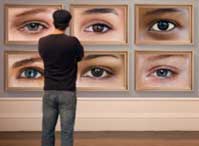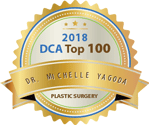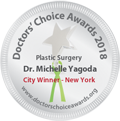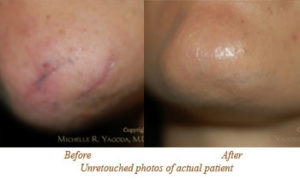When considering scar revision…
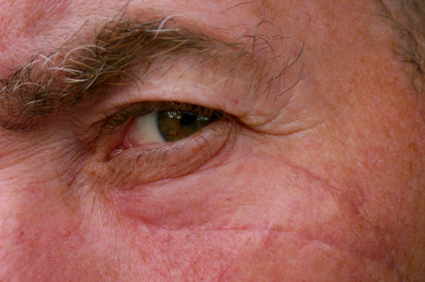 If your wound from an injury or a surgery has healed poorly, what ought to have been a minor scar on your forehead, chin, arms or legs might have turned into one that’s unsightly or even disfiguring. It many have caused you to feel embarrassed or bad about your appearance. Luckily, scar treatment is an option, and one of Manhattan, New York’s top facial plastic surgeons, Doctor Michelle Yagoda, can help you feel more confident about the way you look by making your scars look less noticeable.
If your wound from an injury or a surgery has healed poorly, what ought to have been a minor scar on your forehead, chin, arms or legs might have turned into one that’s unsightly or even disfiguring. It many have caused you to feel embarrassed or bad about your appearance. Luckily, scar treatment is an option, and one of Manhattan, New York’s top facial plastic surgeons, Doctor Michelle Yagoda, can help you feel more confident about the way you look by making your scars look less noticeable.
While no treatment can completely eliminate a scar, topical therapies, supplements, injectable treatments, including fillers, IPL (intense pulsed light)/laser therapy, dermabrasion, chemical peels and surgical revision with better wound closure techniques can help the scar blend more with the surrounding skin so it’s less obvious and objectionable.
What causes poor scarring?
It is important to know that wounds—whether they’re caused by trauma or surgically created—can heal in an unpredictable manner. Even in the best hands, using the least reactive materials, a scar’s appearance ultimately depends on how your body heals. It also depends on other factors such as the location of the wound, its size and depth, the blood supply to the area, and the thickness and color of your skin. In general, those with pale skin tend to heal with the least obvious scars, while those with highly pigmented skin are at risk for poor scarring.
A conspicuous scar on the face (forehead, nose, cheeks, chin) is radically different from the surrounding skin. It may be raised, depressed, or have a different color or texture than the healthy tissue that surrounds it. Scar revision and scar removal are some of the medical and surgical scar treatments that can improve the appearance of scars on the face, arms and legs generally seek to minimize these differences.
Before deciding on scar revision…
It is important to understand that scars typically appear large and unattractive at first; but, in time, they become softer, flatter, whiter, and less noticeable. In general, it is a good idea to wait for at least six weeks after a trauma or surgery, and as long as one year, before deciding on scar revision. It is also important to note that initial care of the wound is important as the interventions that are specific to the different stages of wound healing.
Nonetheless, if a scar on your chin, forehead, arms or legs bother you, there is usually something that can be done (typically in the office) to improve its appearance. Insurance generally doesn’t cover cosmetic procedures and scar removal is typically only covered when there are functional limitations.
Before deciding on a type of medical or surgical scar treatment, consult with Dr. Yagoda to understand all of your options and to be certain that your expectations are realistic. Dr. Yagoda will take the time to address the risks, benefits and likely outcomes of each intervention.
How healthy skin heals
After the skin in injured by accident, or surgery, it heals by having each side of the wound growing toward the other. Eventually, when the two sides touch, this sends a feedback signal to let the two sides know they can stop closing. If this feedback is interrupted, or if it doesn’t exist, the scar continues to grow, leading to an unattractive scar.
Types of poor scars: keloid scars
Keloid scars are raised, wide scars that are often red or dark in color. They occur when the two edges of the wound have made contact, but the feedback to tell them to stop growing is not present. The two sides continue to produce the tough, fibrous protein known as collagen after a wound has closed. This extra tissue clumps up in the area connecting the two sides of the wound.
Keloids occur more commonly in people with highly pigmented skin. Although they can appear anywhere on the body, they most commonly occur in areas of tension (in areas where skin is tight and there is a limited amount of excess skin), flexion (over joints where there is a lot of movement), and over the collarbone, shoulders and earlobes.
Luckily, the risk of developing a keloid decreases with age, and with the use of non-reactive sutures, intraoperative anti-inflammatories, and impeccable surgical technique, the risk can be further reduced. Post-operatively or after injury, the use of silicone gels and steroid injections can also reduce the growth of keloids.
Sometimes, keloids may stubbornly recur. Additional interventions like wound compression or radiation may help, but sometimes, repeat reductions may be necessary.
Types of poor scars; hypertrophic scars
Like keloids, hypertrophic scars also occur because of inhibited feedback. As a result the wound continues to make the collagen. However, in this case, the extra tissue gently rises and then spreads to leave a scar that tends to be wide and flat.
While hypertrophic scars can be improved using some of the same scar treatment techniques, they are often more difficult to get rid of than keloids.
Types of poor scars: wound contractures
When there is a large amount of skin lost from trauma or surgery, the wound closes in a circumferential fashion more than a linear one. As a result, the tissue that is formed to bridge the gap pulls the edges of the skin together in a tighter way than it was initially. This tightening is called a contracture. Contractures can negatively affect the adjacent muscles and tendons, causing restricted movement.
Correcting a scar contracture usually involves cutting out the scar and replacing it with advancement or rotational flap, or a skin graft. (A flap contains its own blood supply. A graft requires a new one.) In some cases a two-stage procedure can be done to repair a contracture: first to insert a tissue expander under the healthy skin to stretch the skin; and, second: to remove the expander and to close the wound with advanced plastic surgery techniques. Then, at about three weeks after the scar revision surgery, physical therapy may be begun to prevent future contracture formation.
A special note about facial scars
The face is front and center and because of that, scars can be more noticeable here (especially on the nose that protrudes and catches a significant amount of ambient and overhead lighting). The good news is that the facial skin has more blood flow than other areas of the skin, and it heals faster with less risk of keloid and hypertrophic scar formation. And, while scars anywhere on the body can potentially be hidden in skin tension lines, facial scars on the cheeks, chin, forehead, nose—also have the added benefit of being able to be hidden in expression lines during scar revision procedures!
A special note about scars from dog bite
800,000 emergency room visits per year are due to dog bites. Unlike wounds caused from other injuries, those caused from dog bites have a 15 x higher rate of infection because of presence of bacterial contaminants in dog saliva, and 40% of the time, they are associated with tissue loss. Dogs sharp teeth can penetrate deeply and as a result carry bacteria deep into the tissues causing a late infection.
Dr. Yagoda provides immediate treatment such as a deep cleaning the wound, starting antibiotics, administering tetanus prophylaxis, and reporting the dog bite to the Health Department to ascertain whether the dog is up to date on rabies and other vaccinations. Doctor Yagoda repairs the dog bite wound by first surgically removing the contaminated tissue, irrigating the tissue with saline or antibiotic solution, replacing lost tissue, and closing the freshened skin edges under magnification.
Scar Removal Procedures
Scar revision techniques include scar excision, Z-plasty, M-plasty, VY advancements and more. Dr. Yagoda removes the old scar and then chooses the best surgical scar revision technique for you. She may even combine several scar treatment techniques in order to reposition a scar in a natural line or crease of the skin so that it is better hidden. This can typically be done in the office and under topical and local anesthesia.
Skin grafts and flaps are options that are more likely to be used after skin cancers are removed from the face via MOHs surgery. Grafting involves taking skin (only skin) from a healthy part of the body in order to cover the area where skin is missing. All grafts leave some scarring at the donor and recipient sites.
Flap surgery is a more complex procedure in which skin, along with fat, blood vessels, and sometimes muscle, are moved from a healthy part of the body to cover the wound. In some flaps, the blood supply remains attached at one end to the donor site; in others, the blood vessels in the flap must be connected to the blood vessels in the area of the wound via microvascular surgery.
Recovery, risks & results
After surgery, the wound must be kept clean and covered with ointment and a bandage. While some may believe that it is helpful to expose the wound to air, studies show that wounds heal faster when they are occluded by ointment and covered with a bandage. Poor scarring can happen when scabs form and become food for bacteria, leading to infection. (Oral antibiotics are not always needed.)
Exercise may be limited for 7-10 days after scar revision surgery so that blood pressure does not become elevated (increases the risk of bleeding) and so that sweating does not occur (can cause infection). Alcohol and certain medications will need to be avoided for a set number of days before and after your procedure as well to ensure optimal results.
It is not uncommon for scars to look red for up to one year after a procedure. Skin may have decreased or increased sensitivity for many months as well. Remember, no matter how it looks initially, your scar will improve with time and with medical and surgical scar treatments.
Book a consultation
To determine if scar revision/scar removal surgery might be right for you, call us to schedule your comprehensive consultation with Doctor Yagoda in her New York City/ Manhattan office.
Read about Dr. Yagoda’s Integrative Post Operative Scar Revision Care Program
Flying In

Listed in the official Diplomatic Directory as a recommended New York physician for out-of-town diplomats, Dr. Yagoda sees international patients often. Her patients come from all over the world.
From Qatar to Quebec, we can help you get here from abroad. Call us to assist you with scheduling a car service to pick you up from the airport—most international flights arrive into New York’s John F. Kennedy Airport or Newark’s Liberty Airport—or booking your hotel room near our office in the Upper East Side.
We recommend the following car services to get from the airport into Manhattan:
- Carmel: (212) 666-6666
- New York Limo: (212) 518-2526
- Dial7: (212) 777-7777
We recommend the following hotels for your stay (Let them know you are having surgery with Dr. Yagoda for a discounted rate):
- Affinia Gardens at 215 East 64th Street. (right across from the hospital): (212) 355-1230
- The Mark Hotel at 25 East 77th Street: (866) 744-4300






























